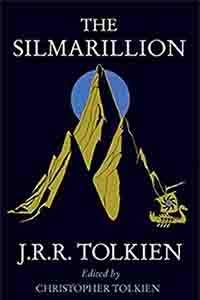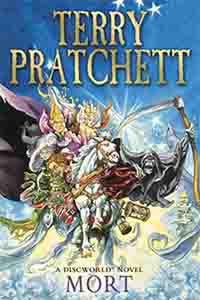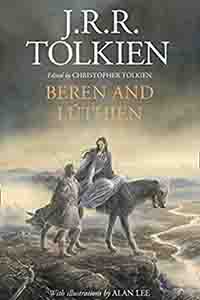“Majestic!…readers of THE HOBBIT and THE LORD OF THE RINGS…will find THE SILMARILLION a cosmology to call their own.”
NO MAJOR SPOILERS
Peter Jackson’s film adaptation of The Lord of the Rings was released when I was a young boy and they served as my passport to the mythical fantasy land of Tolkien’s legendarium. After watching the films on the big screen, I instantly fell in love with Middle-Earth and quickly read both The Hobbit and The Lord of the Rings.
I soon became aware of The Silmarillion, a lengthy tome Tolkien was working on before his death which was published posthumously in 1977. Considered by many to be his magnum opus, The Silmarillion massively expands upon the mythos of Middle-Earth and the world of Arda.

The first time I tried to read The Silmarillion, I was about 12 and found it much tougher going than The Hobbit and The Lord of the Rings and ultimately I gave up. The book was just too dense for me and the huge roster of characters and locations, all with long names, some of which are similar, was too much for my little mind to process. I can distinctly remember sitting in my school library, slugging my way through each page before eventually throwing in the towel. There’s no denying that The Silmarillion is epic in its scope and ambition, and serves as a guide which paints the history of Middle-Earth as clearly as our own real history, but this is a double edged sword. While the hefty book is truly the breath that brings Tolkien’s world to life, it is also the densest of Tolkien’s work and those expecting a more traditional tale similar to The Hobbit or The Lord of the Rings are in for a shock.
I may have stayed firmly in the third age of Middle-Earth as a youngster, but that didn’t stop Tolkien’s work from having a profound influence on me. Every now and then I hear Middle-Earth calling me and I return to Tolkien, either by his books or Jackson’s films, and am instantly transported back to my childhood days spent imagining I was exploring the Shire or hunting Orcs in Mirkwood. After reading and enjoying the recently released stand alone edition of Beren and Lúthien, I decided that it was time I return to The Silmarillion and finish what I started over a decade ago. As a fan of Tolkien, I’d long felt ashamed for not having read what is widely considered his most ambitious tale, and I hoped that this time I would find The Silmarillion a little easier to grasp.
I was relieved to find that this time around the story didn’t feel quite as overwhelming as it had years ago. To be fair to Tolkien, he almost certainly didn’t have children in mind when he penned The Silmarillion and I may have been overreaching when I decided to try and tackle it at such a young age. Sure, The Silmarillion is still a big read for first timers, and I found myself having to look up certain characters and locations to remind myself of their significance but, in my opinion, that just goes to show how detailed and in depth Tolkien’s masterpiece is. It truly does feel like real history and it made me appreciate how one can be a Tolkien ‘scholar’.
The Silmarillion serves as both a creation story for the Arda and how the supreme being Eru Ilúvatar created all life and sent forward his ‘angels,’ the divine spirits known as the Ainur to go forth and shape the lands of Arda. Eru himself created both Elves and Men to populate the lands and the Ainur created the likes of Dwarves, Ents, and Giant Eagles. The first part of The Silmarillion reads almost like a religious text, explaining how all the lands and life of the Arda came to be. The rest of the novel then tells of how one of the Ainur, known as Melkor, rebelled against Eru and began making his own twisted creations. Thus evil took hold and readers are taken through the ages of the Arda as the Ainur, Elves, Men, Dwarves, and Eru himself try to combat Melkor’s desires to corrupt and dominate the world.
It’s a testament to Tolkien’s ambition and world building that both Middle-Earth and the events of The Hobbit and The Lord of the Rings are but a fraction of the history which makes up the mythos of Arda. The lands of Middle-Earth are just one part of the Arda and readers will find themselves exploring new lands and meeting important new characters that are either omitted or only referenced in The Lord of the Rings. Readers will explore the hidden city of Gondolin, learn how the Dwarves came to be, witness the devastation of Melkor and the giant spider Ungoliant, and learn how the love between the Elf Lúthien and the man Beren defied even death.
The book’s namesake, the Silmarils, serve as the focal point, and the three jewels are arguably even more important artefacts than Sauron’s Ring of Power. Created by the Elf lord Fëanor, the Silmarils are three unique jewels who’s beauty rivals even the Valar. They are the pride of the Elves and all other races envy and desire them, including Melkor. After Melkor steals the Silmarils, much of the motivation of characters are tied to the sacred gems and the pride, lust, and envy they inspire permanently shapes the world of Arda.
Given that The Silmarillion begins thousands of years before the events of the War of the Ring, you shouldn’t expect to see many familiar faces crop up, especially at the beginning. Characters that are centuries old by the time of the forming of the fellowship are still young when compared to the thousands of years that have passed from the beginning of The Silmarillion to the destruction of Sauron. However, given their immortality, there are few Elves who feature in both The Silmarillion and the events of The Lord of the Rings, including the likes of Elrond and Galadriel.
As someone who was very familiar with The Lord of the Rings and The Hobbit, I was greatly surprised to find just how much I’d been missing out on and it soon became apparent that those books merely scratch the surface of Tolkien’s world. Not only did The Silmarillion give me many new stories to dive into, but it also helped give me a more well rounded understanding of Middle-Earth and added a great deal of context to why things are the way they are when The Hobbit begins. The Hobbit and The Lord of the Rings are both great places to start when diving into Tolkien’s world, but those who enjoy their time in Middle-Earth should definitely go on to The Silmarillion once the War of the Ring is concluded. I soon came to realise just how small a piece of the puzzle The Lord of the Rings is when compared to the whole picture. Many things I accepted at face value in the Lord of the Rings are examined and explained in detail in The Silmarillion. I know fully understand why Gandalf was able to be resurrected, what the light is in the Phial of Galadriel, and the context for Sauron’s rise to power following the fall of his master Melkor.
Newcomers to Tolkien should absolutely read The Hobbit and The Lord of the Rings first. These books are much easier to digest and serve as an excellent introduction to the world of Arda. Readers who enjoy their time in Middle-Earth and want to learn more about the world it exists in should avoid my mistake and dive right in to The Silmarillion. Sure, it’s denser than the previous books, but the wealth of world building and story is well worth the effort and shouldn’t be too much for readers over the age of about fifteen. It was a pleasure to explore the previous ages of Tolkien’s fantasy lands and I look forward to reading it again in the future where I will no doubt discover new depths I missed on my first read through.
Reviewed by:
Thom Peart
Added 13th July 2018




